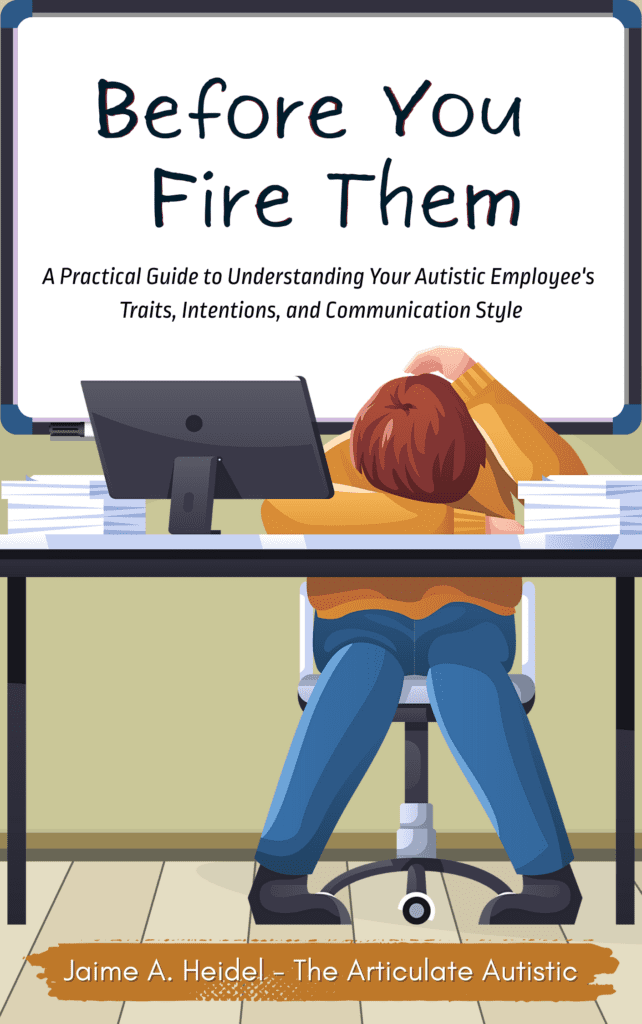“Why Is My Autistic Employee So Lazy?”
!["Why is my autistic employee so lazy?" By: Jaime A. Heidel
[ID: Office interior. Woman with dark hair in a ponytail wearing a button-down, white blouse and a black skirt stands over a man seated at his desk while pointing her finger at him. The man has dark hair and is wearing a blue shirt. He's holding his head in his hands while looking down at his desk]](https://www.thearticulateautistic.com/wp-content/uploads/2025/06/autistic_employee_lazy-683x1024.png)
As a manager working with autistic employees, you may have found yourself getting frustrated and thinking, “Why is my autistic employee so lazy?” If you’re unfamiliar with the autistic neurotype, it’s easy to misinterpret some of our traits. And one of the most commonly misunderstood autistic traits is being a bottom-up thinker (often perceived from the outside as laziness or lack of initiative).
Top-Down Thinking vs Bottom-Up Thinking
Most neurotypical (non-autistic) people have a top-down thinking and processing style. This means their brains automatically apply prior knowledge, expectations, and experiences to their current situation. It’s similar to forming a hypothesis based on the knowledge that’s already present and using that hypothesis to understand new information.
For example, when a neurotypical person gets a new job, their brains transfer the social and professional knowledge gained from their previous job and apply it to the new one without conscious effort.
Most autistic people, by contrast, have a bottom-up thinking and processing style. This means their brains gain understanding from specific details and sensory information, gradually building on them towards a more complex understanding. It’s similar to putting a jigsaw puzzle together by focusing on each individual shape to create the full picture rather than starting with the picture that’s already on the box.
For example, when an autistic person starts a new job, their brains need more up-front guidance and specific details about what’s expected of them to be most effective in their position. That knowledge doesn’t just ‘drop into place’ like it does for their neurotypical colleagues.
Reframing ‘Laziness’ as Lack of Specific Instruction
As you can see, neurotypical and autistic people think, learn, and process very differently, but those differences are not always obvious upon hiring a new employee. In fact, your new hire may not be aware they’re a bottom-up thinker or even that they’re autistic!
This is why companies need to be aware of and be able to implement neuroinclusive accommodations, even without a diagnosis or disclosure on the part of the employee.
Let’s look at an example of how bottom-up thinking can look like laziness:
Gerald is an autistic 20-something who has worked at a clothing store for two weeks. His interview went well, his references were good, and he seemed eager and ready to join the team on his first day.
Two weeks into the position, however, Gerald has handled the customers well while ringing them out, but when there are no customers in the store, Gerald leans against the counter and scrolls through his phone.
He seems to have no interest in straightening out the clothing racks, cleaning up the store, or offering to help his co-workers, even when they’re struggling to maintain the floor during the busiest times of the day!
While Gerald’s behavior may look like purposeful laziness, doing the bare minimum for a paycheck with maybe even a little entitlement to boot, that’s not what’s going on.
Gerald isn’t straightening clothing racks, cleaning the store, or offering to help his co-workers because he hasn’t been specifically instructed to do so!
“But, that’s common sense!”
Actually, what most people think of as ‘common sense’ is top-down thinking at work. Bottom-up thinkers often get caught up in expectations they don’t understand due to a fundamental lack of knowledge that this thinking style even exists.
If you have an employee like Gerald who seems to be purposefully shirking responsibilities and cutting corners, take a deep breath and reframe your thinking. Could your employee be autistic? Could they have a bottom-up thinking style? If so, you can accommodate them without directly discussing neurological differences.
Supporting a Bottom-Up Thinking Style
Bottom-up thinkers need specific details and instructions. If the role you hired your autistic employee for comes with expectations that are not clearly spelled out, clearly spell them out. Talk with your employee about what’s expected of them, and follow that talk with a written list of those same job expectations. You can also provide visual supports for more complicated, multi-step processes to make them more neuroinclusive.
The Takeaway
Your autistic employee isn’t lazy; they just need different training. When you meet traits you don’t yet understand with curiosity instead of assuming negative intent, you create a safer, more constructive workplace environment where everyone, regardless of neurotype, can benefit and thrive!
My new book, Before You Fire Them – A Practical Guide to Understanding Your Autistic Employee’s Traits, Intentions, and Communication Style, aims to clear up misunderstandings and help you train and work with your autistic employees more effectively from day one! Purchase your copy today on Amazon and Barnes & Noble.
Looking for more purchasing options? I published through IngramSpark, which is distributing my book globally. The rollout for the paperback is slow, but the eBook is available in several other places. A quick Google search should help you find it in your area. 🙂



